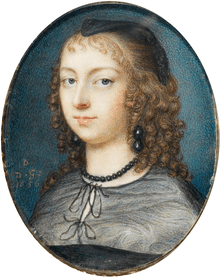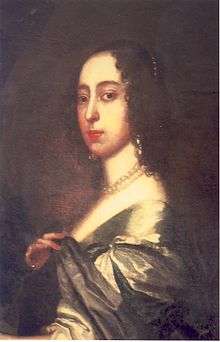Rachel Bourchier, Countess of Bath
Rachel Bourchier, Countess of Bath[lower-alpha 1] (28 January 1613 – 11 November 1680) (née Fane), the wife of Henry Bourchier, 5th Earl of Bath (1587-1654), was an English noblewoman and writer,[1] best known for her activities during the English Civil War.


Origins
She was born at Mereworth Castle in Kent, the fifth daughter of Francis Fane, 1st Earl of Westmorland by his wife Mary Mildmay, a daughter of Sir Anthony Mildmay of Apethorpe Hall in Northamptonshire, where Rachel grew up. Rachel's brother, Mildmay Fane, 2nd Earl of Westmorland, a poet and dramatist, was close to King Charles I, who became a godfather to Fane's son in 1635. Another of Rachel's brothers was Colonel George Fane, who also supported the Royalist cause.
Youth
In her youth Lady Rachel Fane wrote masques for performance at family entertainments.[2] One of these was her "May Masque" of 1627.[3]
Marriages
First marriage
On 13 December 1638, at the age of 25, in the church of St Bartholomew the Great in the City of London, she married the 50 year-old Henry Bourchier, 5th Earl of Bath (1587-1654) of Tawstock Court in Devon. By 1642 during the Civil War he was active in the Royalist cause, and wrote to his wife from York and London about the progress of the War.[4] In December 1642 the House of Lords ordered Thomas Browne to return the horses he had commandeered from the countess on behalf of Robert Devereux, 3rd Earl of Essex, the Parliamentary commander.[5] She bore him no children, although in 1663 she became the guardian of her nephew, Sir Henry Fane (d.1706), the only child of her brother George Fane.
Following Bourchier's death in 1654, Rachel commissioned a striking monument in his memory, which survives in the south aisle chapel of St Peter's Church, Tawstock. Opinions vary as to its artistic merit, with Hoskins (1954)[6] calling it "massive and ugly", while J. H. Marland deemed it "almost unequalled in singularity and absurdity".[7] It is constructed in black and white marble, with four dogs supporting a sarcophogus on their shoulders with a black obelisk at each corner.[8]
Second marriage
Six months after the earl's death, she married Lionel Cranfield, 3rd Earl of Middlesex (1625-1674) , who was 12 years her junior,[9] a Gentleman of the Bedchamber to King Charles II. The marriage was not a happy one and the couple lived apart from 1661 onwards. After Cranfield's death in 1674, Rachel did not remarry.[10]
Monuments
The life-size white marble statue of Rachel Fane, sculpted by Balthasar Burman (son of Thomas Burman),[11] which survives in St Peter's Church, Tawstock, is a copy of the statue of Mary Cavendish (1556–1632) the wife of Gilbert Talbot, 7th Earl of Shrewsbury,[8] sculpted in 1671 by Thomas Burman at the cost of her nephew William Cavendish, 1st Duke of Newcastle (1592-1676), which stands in a niche on the Shrewsbury Tower of the Second Court (which she partly financed) of St John's College, Cambridge.[12]
Sir Anthony van Dyck painted two portraits of Rachel, one prior to her first marriage, which survives, and another in 1641, for which she paid him £20,[13] of which only an engraving survives, by Pierre Lombart. A miniature of the countess by David des Granges is held by the Fitzwilliam Museum, Cambridge.[14]
In a 1670 work by Sir Kenelm Digby, a recipe for syllabub appears, attributed to the countess.[15]
Notes
- Alternatively Rachael
References
- Caroline Bowden, "The Notebooks of Rachael Fane: Education or Authorship?," in: Early Modern Women's Manuscript Writing, edited by Victoria E. Burke and Jonathan Gibson; London, Ashgate, 2004; pp. 157-80.
- Marion O'Connor, 'Rachel Fane's May Masque at Apethorpe, 1627', English Literary Renaissance, vol. 36, No. 1 (Winter 2006), pp. 90-113
- Nadia T. van Pelt. "Review of Deanne Williams, Shakespeare and the Performance of Girlhood (New York: Palgrave Macmillan, 2014)". Journal of the Northern Renaissance. Retrieved 14 August 2016.
- "Letter from her husband Henry, Earl of Bath". The National Archives. Retrieved 14 August 2016.
- Gavin Robinson (22 April 2016). Horses, People and Parliament in the English Civil War: Extracting Resources and Constructing Allegiance. Routledge. p. 121. ISBN 978-1-317-12127-5.
- Hoskins, W.G., A New Survey of England: Devon, London, 1959 (first published 1954), p. 489
- Harris, G.T., "Some Memorials in Devon Churches", Devon Notes & Queries, XIV: 90
- "Church of St Peter, Tawstock". British Listed Buildings. Retrieved 14 August 2016.
- "Fane, Lady Rachel (Countess of Bath)". The Diary of Samuel Pepys. Retrieved 14 August 2016.
- "Middlesex, Earl of (E, 1622 - 1674)". Cracroft's Peerage. Retrieved 14 August 2016.
- Pevsner, Nikolaus & Cherry, Bridget, The Buildings of England: Devon, London, 2004, p.790
- 'St. John's College', in An Inventory of the Historical Monuments in the City of Cambridge (London, 1959), pp. 187-202 See imagesFile:St John's College Second Court, Cambridge, UK - Diliff.jpgFile:St John's College, Cambridge, second court 04.JPG
- Gray, Todd (1996), Devon Household Accounts, 1627–59, Part II, Henry, Fifth Earl of Bath and Rachel, Countess of Bath, 1637–1655, Exeter: Devon and Cornwall Record Society
- "Lady Rachel Fane, Countess of Middlesex, by Des Granges". Fitzwilliam Museum, Cambridge. Retrieved 14 August 2016.
- "Lady Rachel Fane's Syllabub". Food jottings. 17 December 2011. Retrieved 14 August 2016.